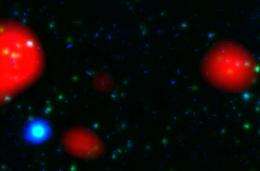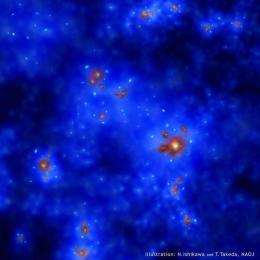Star-Forming Backbone of a Massive Structure in the Early Universe Photographed

(PhysOrg.com) -- Using a special camera known as AzTEC developed by a research team led by Grant Wilson, astronomy professor at the University of Massachusetts Amherst, an international research group has imaged a set of ultra-massive galaxies that are thought to form the backbone of a super large structure, or collection of galaxies congregated together, in the very early universe.
The cluster of galaxies about 11.5 billion light years away is described in a recent issue of the journal, Nature, by lead investigator Yoichi Tamura of the University of Tokyo and Japan’s National Astronomy Observatory (NAOJ), with colleagues at UMass Amherst and other universities in Mexico and the United States. Their findings are very valuable for understanding how galaxies formed in the early universe, when it was less than 2 billion years old, and at a time when clusters of galaxies were just beginning to be formed, the researchers say. The universe is estimated to be about 13.7 billion years old.
For this study, astronomer Min Yun at UMass Amherst, with Wilson and graduate students Jason Austermann, Kimberly Scott and others, pointed the telescope and the AzTEC camera toward the constellation Aquarius, an area known since the 1990s for hosting hundreds of small yet optically bright galaxies called Lyman alpha emitters in the remote Universe.
The new study provides the first direct observational evidence for coincident grouping of optically dim, ultra-massive, starbursting systems which may form the underlying backbone of the growing cluster very early in the universe’s life cycle, Wilson notes. “We call this star formation starbursting because it’s thought to be a rather violent and short-lived phase, about 50 million years, in the galaxy’s life,” he adds.

These ideas are consistent with those predicted by current thinking on the formation of cosmic structures in the Big Bang paradigm. And, the data are in general agreement with theories of how massive galaxies come to be preferentially found in galaxy clusters.
It’s exciting to find these ultra-massive galaxies coexisting beside the Lyman alpha emitters, which themselves have been caught in the act of forming a young cluster of galaxies, according to Wilson. “This is akin to finding a flock of owls congregating around a group of fireflies at night,” says Wilson. “We’ve known about the fireflies for several years because they glow and are relatively easy to see. But these recent measurements show there’s a lot more hidden in the darkness. Now the question is, are the fireflies there because of the owls, or are the owls there because of the fireflies?”
Further, as Wilson explains, the newly discovered galaxies are encased in a cocoon of dust created by their own prolific formation of new stars. Although they are some of the most massive galaxies formed and so the stars inside might be expected to be more visible, most of their optical light is unable to penetrate the dust, making the galaxies nearly invisible even to the most powerful optical instruments such as the Hubble Space Telescope. The AzTEC camera, destined to become part of UMass Amherst’s Large Millimeter Telescope, senses the thermal glow from this warm dust and allows astronomers to “see” the otherwise hidden galaxies.
AzTEC, the UMass Amherst instrument, was funded in part by the National Science Foundation. It will be installed at the Large Millimeter Telescope, a 50-meter millimeter-wavelength telescope nearing completion in Mexico. The 10-m submillimeter telescope, ASTE, is operated by NAOJ and the University of Tokyo in collaboration with the University of Chile, Nagoya University, Osaka Prefecture University, Ibaraki University, and Hokkaido University.
Provided by University of Massachusetts Amherst (news : web)

















